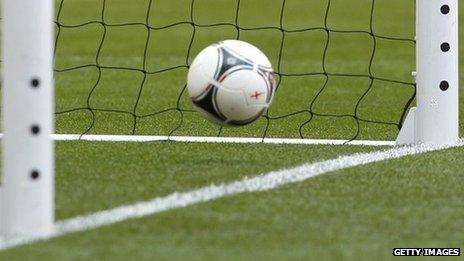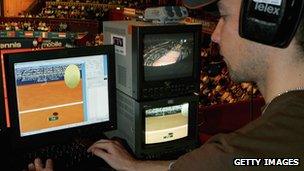Hawk-Eye: From concept to game changer
- Published

Hawk-Eye's goal-line technology will be installed in 20 Premier League stadiums as well as Wembley Stadium in London
Hawk-Eye's deal to provide Premier League goal-line technology marks another step in the company's rapid rise from a simple concept dreamed up by a sports fan with a PhD in artificial intelligence to an essential piece of kit used in major sporting events across the globe.
Originally an innovation for television coverage of cricket, Hawk-Eye has become a trusted tool for officials in cricket, tennis and now football.
When the company was launched in 2001, it had two full-time employees based in Winchester.
Fast-forward to 2013 and it is now owned by Sony, has 65 full-time staff and the technology is installed in 230 stadiums worldwide.
Dr Paul Hawkins came up with the idea in 1999 and after 18 months of development, the technology made its debut during Channel 4's coverage of the 2001 Ashes series.
A Royal Society Television Award for technical innovation followed, and the company Hawk-Eye Innovations Ltd was established - with a focus on developing the technology for use in tennis.
A year later, Hawk-Eye was used in this way for the first time during the BBC's Davis Cup coverage. It received two more TV awards for innovation in 2003 and 2004, including an Emmy.
World Cup disappointment

Hawk-Eye was first used by tennis umpires in 2005
After some controversial line-calls in major tennis matches, some questioned whether the technology could be used for more than just the benefit of a TV audience.
The International Tennis Federation eventually approved the use of Hawk-Eye as an aid to be used by umpires, should any judgements be disputed or too close to call.
Hawk-Eye was first used in a tennis tournament in 2005, making its official Wimbledon debut in 2007.
Despite being praised by many, not everyone has been in favour of the technology.
Most notably, 17-time Grand Slam winner Roger Federer has said in the past that Hawk-Eye is not accurate enough and has even called for it to be scrapped.
But such criticism has not hindered the technology's global success, and in 2011 the company was bought by Sony for an undisclosed sum.
The firm's staff and developers are now based at Sony's European headquarters in Basingstoke, Hampshire, where the units are put together in a warehouse on site.
A number of staff are also based abroad, following tennis tours and working at international stadiums.
The company had a setback in early 2013, when it missed out on the contract to supply goal-line technology for the 2014 World Cup to its German rival, GoalControl.
But the Premier League deal confirms Hawk-Eye as a leading player in football's greater use of technology to assist officials.
The company's accounts are private, but the agreement with the Premier League is reported to be worth millions of pounds.
- Published7 March 2011